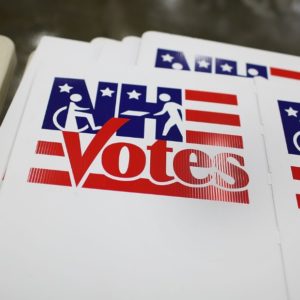Secretary of State David Scanlan is predicting about one in four New Hampshire voters will turn out in Tuesday’s primary, a solid performance, but well below 2020’s record-setting numbers.
“As of Thursday, Sept. 5, there were a total of 895,498 registered voters, consisting of 300,672 Republicans, 258,824 Democrats, and 336,002 undeclared voters,” according to Scanlan.
The Granite State’s top election official said he thinks 147,500 voters will cast Republican ballots while 103,500 will do the same for Democrats. The 251,000 total votes that Scanlan is predicting would mean a 28 percent participation rate among registered New Hampshire voters, but it would fall short of 2020’s record 303,193 total.
If 147,500 voters turn out to cast Republican ballots on Tuesday, it would almost perfectly match the 147,501 GOP votes cast in 2020, a race that featured a U.S. Senate primary.
For Democrats, however, Scanlan predicts a significant drop. Nearly 156,000 Democratic ballots were cast in the 2020 primary.
Some veteran campaign operatives tell NHJournal they believe Scanlon’s number is low, particularly among Democrats. They believe having competitive — and negative — primary campaigns for governor and the Second Congressional district will drive up turnout. But Scanlan believes he’s got it right, in part because he believes 2020 was an exception, not a benchmark.
“You have to remember 2020 was an unusual year, thanks to COVID,” Scanlan told NHJournal. “The use of mail in ballots and effects of the lockdown changed voting patterns.” With fewer people going to work and an emphasis on mailing in ballots, New Hampshire essentially had an “Election Season” rather than an Election Day. And given Democrats’ propensity for mail-in balloting, the net result was high turnout.
Interestingly, that record turnout in the primary didn’t help in November, when New Hampshire Republicans flipped control of both chambers of the legislature — the only state GOP to do so — and Republican Gov. Chris Sununu was easily reelected.
“I think we are going to have good turnout, but I don’t think we’ll be setting any records,” Scanlan said.
Driving turnout at the top of both party’s tickets is the race for governor, with polls indicating a much closer contest on the Democratic side between former Mayor Joyce Craig and Executive Councilor Cinde Warmington than many political strategists anticipated. A series of eye-catching ads launched by Craig targeting Warmington’s decades-old work on behalf of OxyContin maker Purdue Pharma have amped up the animosity level between the two. Warmington responded with hard-hitting attacks on Craig’s record as Manchester mayor.
“Joyce Craig says she wants to run New Hampshire like she ran Manchester? Seriously? If so, Democrats will lose New Hampshire the way they lost Manchester,” Warmington said during the WMUR debate on Wednesday.
The Aug. 19 University of New Hampshire Survey Center poll placed Craig ahead of Warmington 39-30 while the Aug. 14 Saint Anselm College Survey Center poll showed the same margin favoring the former Manchester mayor, 37-28.
On the Republican side, Senate President Chuck Morse is waging an energetic race against former U.S. Sen. Kelly Ayotte and is credited with a strong performance in the WMUR debate. But polls show Ayotte with a strong lead, and she has outspent him on TV and campaign mail. Saint Anselm had Ayotte leading Morse 59-25 while UNH showed a similar gap with Ayotte in the lead, 65-21.
If there is a surprise in Democratic turnout, it is likely to come from the Second Congressional District, where outgoing U.S. Rep. Annie Kuster’s plans for a coronation of former Executive Councilor Colin Van Ostern have been upended. First-time candidate Maggie Goodlander, a scion of the wealthy Tamposi family who hasn’t lived in the district in two decades, has spent millions on attack ads against Van Ostern.
Kuster has appeared in ads returning fire against Goodlander. “Let’s send New Hampshire candidates to Washington, not the other way around.”
Another factor that may impact turnout: no U.S. Senate primary. Those races tend to draw both attention and money to primary elections.
In 2018, the last cycle without a U.S. Senate race, total turnout was 228, 262, well below Scanlan’s prediction for Tuesday. Just two years ago, 96,275 Democratic ballots were cast and 147, 501 for the GOP, a total of 243,776 in the 2022 primary, also behind Tuesday’s projection.
This year’s primary turnout will be driven by the races for governor, drawing a comparison to 2016. Approximately 111,271 voters cast Republican ballots when Sununu edged out Frank Edelblut, and 72,500 cast Democratic ballots in Van Ostern’s victory over Steve Marchand and Mark Connolly.
UNH’s poll showed Goodlander leading Van Ostern, 34-28, with 38 percent still undecided. Saint Anselm also gave the edge to Goodlander, 41-31.
Meanwhile, both congressional GOP primaries have drawn crowded fields of candidates which polling shows all share a common problem: name recognition. In the First Congressional District, Saint Anselm’s poll found 59 percent – in line with UNH’s finding of 60 percent – of Granite State voters don’t know enough about any of the top five candidates to make an informed decision.
Ditto the Second Congressional District, where Saint Anselm’s poll found 57 percent remain undecided. UNH’s poll results were more forgiving for GOP candidates with 49 percent listed as undecided.
A more similar comparison to 2024 may be found in the 2016 state primary results. Like 2024, 2016 saw Granite State voters presented with new choices for governor as then-Democratic Gov. Maggie Hassan opted to make a run for U.S. Senate.
Approximately 111,271 cast Republican ballots in the race won by Sununu while 72,500 cast Democratic ballots in a primary won by Van Ostern.
On Tuesday, Scanlan is scheduled to tour primary day poll locations with Jen Easterly, director of the federal Cybersecurity and Infrastructure Security Agency (CISA).





